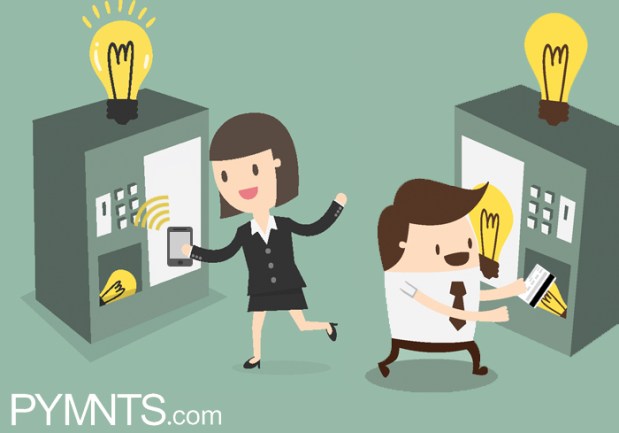Bringing Digital Payments To 13 Million New Merchant Locations

Unattended retail is the sleeper of the payments industry. This $120 billion sector in the U.S. includes everything from vending, commercial laundry, and self-serve kiosks, to arcades. It’s also estimated that there are between 13 and 15 million locations ready and waiting to move from cash to digital payments. In a recent podcast interview, MPD CEO Karen Webster sat down with Michael Lawlor, Senior Vice President of Sales & Business Development at USA Technologies, to talk about why this sector is now waking up to the digital potential, and why unattended retail is likely to be one of the fastest growing sectors of retail in the years ahead.
Unattended retail is the sleeper of the payments industry. This $120 billion sector in the U.S. includes everything from vending, commercial laundry, and self-serve kiosks, to arcades. It’s also estimated that there are between 3 and 15 million locations ready and waiting to move from cash to digital payments. In a recent podcast interview, MPD CEO Karen Webster sat down with Michael Lawlor, Senior Vice President of Sales & Business Development at USA Technologies, to talk about why this sector is now waking up to the digital potential, and why unattended retail is likely to be one of the fastest growing sectors of retail in the years ahead.
KW: Unattended retail or self-service retail is an area that a lot of people are curious about. Give us a sense of what the self-serve retail industry is, why it’s complicated from a payments standpoint and what USA Technologies is doing to help simplify it.
ML: Sure, let me start by explaining what the self-serve retail business is here in the US market.
Many people know the vending space as the largest sector, but unattended retail also includes commercial laundry, the amusement and arcade sector, and self-serve kiosks. It’s a pretty substantial-sized opportunity – when you put all of those industries together, it’s about $120 billion in annual sales which consists of 13-15 million various vending machines, laundry equipment, and arcades out there as potential opportunities. And the card associations view this one of the biggest, last opportunities of cash-based businesses that they’re trying to migrate into electronic payments. The great thing is that it’s largely untapped – we believe the total penetration so far is less than 10 percent. So USA Technologies is in a unique position with our solutions.
Anywhere there is a self-serve application where there is a payment involved, which has historically been cash-based, is an opportunity for our solution to be used, allowing vendors to more easily move into electronic payments. That’s the opportunity – also the challenge of payment enabling them.
KW: So a vending and an arcade solution sound like they are at total opposite ends of the complexity spectrum. Help us understand how you deploy these digital solutions in those environments.
ML: The whole self-serve retail sector is uniquely different than the traditional brick and mortar retail business in terms of what it takes to implement and deploy electronic payments. But that’s what we’ve built our systems and network architecture around.
To make it simple for the operator, we put all of the components together from a wireless point of sale terminal and work with the host equipment, incorporating wireless services into that POS terminal. We do all of the merchant set-up and processing in a simplified single-rate methodology, which alleviates the complexity of interchange. We also provide all of the sales reporting on a machine-by-machine basis. We take all of this and roll it up into a comprehensive end-to-end solution to make it easy for those who own the self-service machines so they don’t have to put all of the pieces together themselves.
On the consumer side, we accept both traditional magstripe credit and debit cards, but we’ve also incorporated various types of contactless or mobile payments into our platform so we enable the people who own and operate these machines to take multiple forms of electronic payments.
KW: So I can imagine that closed environments like university and employee campuses look to self-serve kiosks as opportunities to expand their points of service, but that there would be integration challenges with new these points of service and existing electronic payment infrastructure. How do you solve for that?
ML: You’re exactly right. A lot of our customers work in those environments where they not only provide vending services – they provide new micro-markets and food service. We’re uniquely positioned in that we’ve expanded our services to integrate micro-markets and food service and mobile food delivery in order to provide the same ePort Connect turnkey suite of services across the spectrum, whether it’s cashless and contactless payments, M2M telemetry services, prepaid and loyalty, mobile marketing, or mobile merchant solutions. We can offer them the single source card processing, bunded processing rates, integrated loyalty programs, and more.
KW: That must provide lots of opportunities to expand points of service and revenue. How do you talk about the ROI in those environments – how do you justify the cost of installing in these micro-markets?
ML: Well, just like they’ve seen the benefits of electronic payments acceptance in vending, they’re seeing the same benefits or ROI in these other micro-markets and food services. The ability to allow the consumer to use their credit, debit or prepaid loyalty program cards is just driving more sales and higher spend so the benefits are there. Our ability to tie all of those points of acceptance back to our network and platform allows us to simplify the processing through one processor.
As an example, we have one client for whom we’ve reduced their processing cost by 35 percent, saving them $40,000 annually. So, this is a big opportunity for us. The customers we serve in vending and across commercial laundry and amusement sectors have a need for each of their machines; we can enable all of their payment service needs.
KW: So, I’m curious, you mentioned a number of segments at the top of our discussion. Which of those areas do you feel is the furthest along, and which do you think has the most ground to gain?
ML: The vending industry is the largest and furthest along, so they’ve realized the benefits of what cashless can do for them. Because we have such a large share in the vending sector, 78 percent of all deployments, we’ve seen the data that shows significant increases in sales – anywhere from 25-30 percent – from the deployment of our cashless payment solutions.
KW: So how do you talk to customers about the ROI of making that investment?
ML: Well, there will always be a cost of cash and cashless, but again, because they’re seeing increases in sales attributable to accrediting debit and credit and loyalty and prepaid, the benefits far out-weigh the costs associated with it. The other thing is that once they’ve incorporated cashless payments, there are other benefits that come along with having a wirelessly connected machine. They can extract other data from the machine, like inventory levels, to run their business more efficiently. So they clearly see it as a compelling business case.
And as we talk about our ePort Connect services, we’ve future-proofed it to add new services on top of that. We’re headed next toward the area of consumer engagement with loyalty and prepaid programs, gathering more consumer data so that merchants can engage with consumers to offer them the best incentives and rewards.
KW: Are most of these self-service players interested in moving from cash to the magstripe card or are they thinking that they want to jump right to mobile?
ML: We decided many years ago that we wanted to enable electronic payments in whatever form the consumer wanted to use. So we incorporated NFC and other contactless payment forms, and we probably have some of the largest deployments of mobile payment acceptance across the US market. Some of the mobile wallet companies like ISIS have taken advantage of that, and we do various national rewards and consumer loyalty programs with our mobile footprint.

Michael Lawlor
Senior Vice President of Sales & Business Development, USA Technologies
Michael K. Lawlor is responsible for USA Technologies’ sales and business development efforts for cashless payment and M2M telemetry solutions for the vending, kiosk and other similar markets as well as energy-saving products. Since joining USA Technologies in July 1996, he has helped to drive USAT’s leading market position through innovative sales programs, national partnerships and development of expanded services. Prior to joining the Company, Mr. Lawlor had been employed by the Pepsi Cola Co, a division of PepsiCo. During his employment at the Pepsi Cola Co, Mr. Lawlor held roles as Regional Sales Manager for the Houston, TX region, managing their restaurant and vending business sectors and as a National Accounts Sales Manager on the Pepsi Cola national food service team, responsible for managing both corporate and franchise relationships with multiple national restaurant chains. Mr. Lawlor graduated with a Bachelors of Business Administration from the University of Texas in 1986.
To listen to the full digital discussion, click here.
